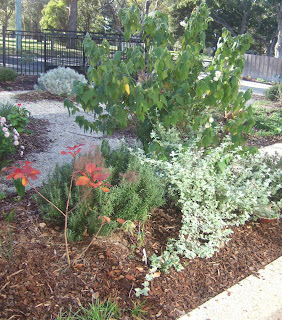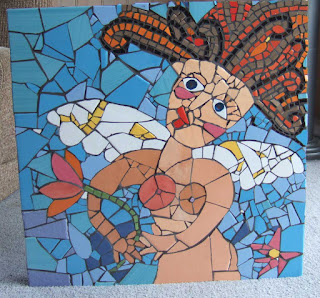This house is different. It was a house planned for an unpredictable future while at the same time trying to make the most of everything that was available to it. We combined all of the aspects of our lives together that we have most cherished, and incorporated them with scientific data about future climate as best we could envisage, to make something that is uniquely us. We trimmed and compromised our wishes, and while the building work went on with all its hassles I dreamed of the places I would sit and wonder in the garden.
It was at worst a terrifying experience, after the initial euphoria of committing to it and there were many dark moments when our control of the project was in the hands of a Dr Jekyll builder, who at times broke our hearts with his callous and shoddy interpretations of our design.
When the builders left 2 years ago our house was sitting in this.
Our excitement about moving into our new home and starting a new chapter in our lives was being shattered on a daily basis and the builder's parting gesture of leaving us with 2 tonnes of rubble and a skip full of building junk was nearly the last straw. We had lived in a dodgy brothers rental that we had had to sandbag for 2 years, put our beloved dog
into an adoption program and then had to move one more time for 8 weeks into my old childhood home which had been empty and decaying for a year. To add insult to injury when we finally moved, the heating and stove were not connected for another 3 weeks in the middle of winter. Our bodies sucked up all the stress and continued to feed it back to us for the next few months.
The garden saved me.
Having a project that was big and unbelievably physical and so exposed to passing public, was a catharsis. After lugging and digging and bending for 8 hours a day for 3 solid weeks of freezing weather in order to create the skeleton framework for the garden, I had no choice but to sleep at night.
I met passersby who were cynical about our strange new building. I met xenophobes who couldn't bear to see their neighbourhood changing. I met endless dogwalkers and encouraging gardeners, and I gradually insinuated myself into my new space. As much as possible of the building rubbish and packaging has been built into shaping garden edges and mounds and I am constantly finding new ways to rehabilitate another part of the garden. The previous garden was loved and owned by one owner and I promised her when we bought the block that I would try to preserve as much as possible or to plant another garden of beauty. Many of the first plants came from her plants which I rescued before building began. We have kept the 60 year old fig tree, a flowering gum, a callistemon plus a Tangelo and Valencia orange tree as well as smaller old fashioned shrubs. Other plants came from my childhood home along with hundreds of tiny tubes of plantlets which looked painfully insignificant to begin with.
2 years on I have lived off food from 52 different plants in my garden. I have rehabilitated a filthy abused building site into a sanctuary for birds, frogs and small critters, and I always have something in my garden to offer to visitors which is something I really love to share.
I love listening to passing children on their way to school or the park, wishing they could live at my place and explore it. It freaked me out at one time to have people stop and photograph the house and garden (even at midnight), but now I get a bit of a giggle to see aspects of our house copied around the place and I can happily suck up the compliments from passing admirers.
The best part of creating a garden is that it is an evolving and interactive work of art. You can predict sizes of plants and recognise the conditions which will help them to thrive but they will change and respond to one another and the climate in ways that we humans are too fallible to predict. If I have estimated correctly many of these plants will continue to contribute benefits to the heating and cooling of our home in years to come. I have played computer games like Sim City and other simulated organic developmental programs but no digital experience is a substitute for this real life.
A garden responds to love, but also offers surprises and delights when you least expect them. It is the ultimate science laboratory, pantry, teacher and healer. I have relearned hope with grace from nature. I have more confidence about who I am because I have made a big thing that I know is going to become more beautiful with age and with any luck might last as long as the garden before it.
An encouraging neighbour at this time last year quoted me an old adage about gardens. "In the first year they sleep. In the second year they creep and in the third year they leap."
She was right about these first two years so next year might be astounding. Happy anniversary House!


































